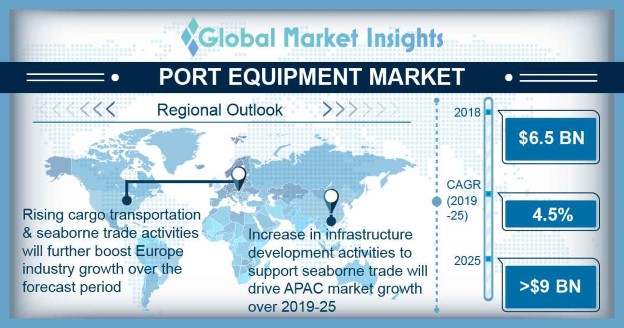Home > Automotive > Automotive Logistics > Freight Logistics > Port Equipment Market
Port Equipment Market Size
- Report ID: GMI3288
- Published Date: Jul 2019
- Report Format: PDF
Port Equipment Market Size
Port Equipment Market size valued at USD 6.5 billion in 2018 and is expected to witness over 4.5% CAGR from 2019 to 2025.
Increasing seaborne trade across the globe will prominently drive the port equipment market size. According to the United Nations Conference on Trade And Development (UNCTAD), in 2018, the seaborne trade surged by around 4% as compared to 2017. The sea freight services offer multiple benefits including large cargo space availability, economical, and safety. Expanding maritime logistics services will drive the industry growth over forecast timeframe.
| Report Attribute | Details |
|---|---|
| Base Year: | 2018 |
| Port Equipment Market Size in 2018: | 6.5 Billion (USD) |
| Forecast Period: | 2019 to 2025 |
| Forecast Period 2019 to 2025 CAGR: | 4.5% |
| 2025 Value Projection: | 9 Billion (USD) |
| Historical Data for: | 2014 to 2018 |
| No. of Pages: | 400 |
| Tables, Charts & Figures: | 509 |
| Segments covered: | Equipment, Application, Type and Region |
| Growth Drivers: |
|
| Pitfalls & Challenges: |
|
Rising trading activities is increasing the vessel size and cargo volume adding further pressure on yards and ship berths. Organizations are allocating investment to enhance the facility. For instance, in May 2019, UK announced to allocate around USD 220 million for expanding Port of Dover. Further, the ports are incorporating smart solutions to optimize operations, reduce logistics costs, and enhance the efficiency.
Increasing awareness regarding carbon footprint and inclination towards the environment friendly transportation will drive the port equipment market value over the study timeframe. The road and air transportation have higher carbon footprint as compared to sea transport. According to the International Chamber of Shipping (ICS), shipping generates around 3-8 gram per tonne-km as compared with 80 gram per tonne-km by trucks.
Government regulation limiting the carbon emission from port equipment is leading to the adoption of alternate fuel consumption equipment. The ports are incorporating the alternative fuel equipment to minimize the logistic carbon footprint thereby supporting the industry size. For instance, Europe allocate an investment of USD 4.5 million for H2Port project to adopt hydrogen fuel cell equipment at ports.
Adoption of automated equipment are enabling the port operator for convenient and easier handling of port cargo thereby supporting the port equipment market growth over study timeframe. Several ports are planning to adopt the unmanned port equipment. For instance, in February 2019, APM Terminal announced plan to use unmanned straddle carriers at Pier 400 terminal in California.

